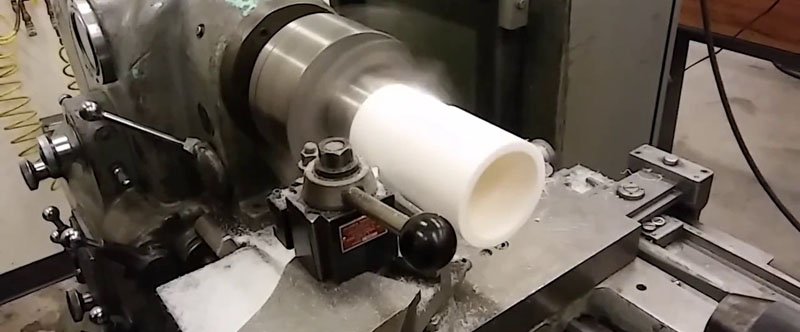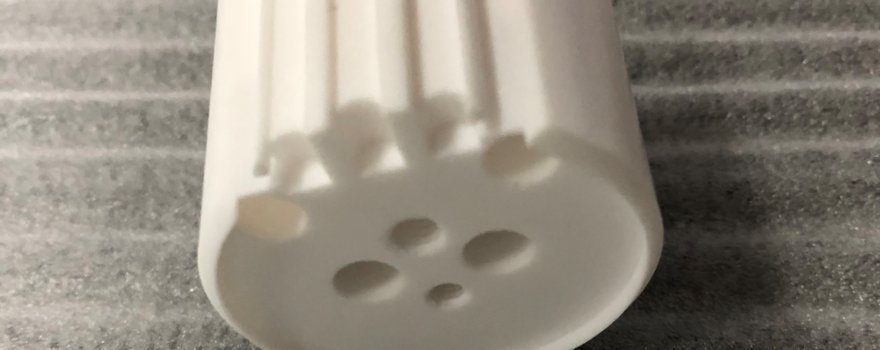Polytetrafluoroethylene (PTFE), the most well-known brand name is Teflon, is a synthetic fluoropolymer thermoplastic. PTFE-Teflon is different from most engineering plastics because it has a high melting point, low friction coefficient and chemical Inert.
Despite its general mechanical properties, Teflon is chemically resistant and stable even at high temperatures, making it a popular material for many specific applications.
One of the best ways to manufacture Teflon parts is CNC machining. This article focuses on the ins and outs of processing Teflon: its material properties, advantages of processing it, common applications and processing techniques.
What Is Teflon?
PTFE is a fluoropolymer of thermoplastic and tetrafluoroethylene. It is a white solid at room temperature, and PTFE consists only of carbon and fluorine. As a fluoropolymer, PTFE has inherent resistance to solvents, acids and alkalis. It is hydrophobic, has extremely low friction, and because the bond between carbon and fluorine is very strong and non-reactive, it is one of the strongest bonds available in organic chemistry.
We have already said that Teflon is a thermoplastic, but what does this mean?
All polymers can be more or less divided into two categories: thermoplastics and thermosets. The main difference between them is the way they react to heat. For example, thermoplastics like Teflon will melt when heated, while thermosets will remain “solidified” once they are formed. Understanding the technical differences between these types of materials is essential for correct CNC machining.

Advantages Of Teflon Machining
Teflon processing has several advantages, including the inherent material advantages of PTFE and the advantages derived from the processing process.
Material Advantages
Excellent chemical resistance and heat resistance
Low friction, non-sticky
Good weather resistance
Stable at temperatures up to 500°F
Excellent electrical insulation properties
Relatively high strength-to-weight ratio
Machining Advantage
Easy to process due to softness and high density.
Excellent thermal stability prevents part deformation and tool clogging.
Limitations Of Teflon Machining
The density and softness of PTFE make it easy to process. In the original grade, the temperature range is -450°F to +500°F (-267.7°C to +260°C). Compared with nylon and other materials, the strength of Teflon is lower, and the tensile strength of nylon is almost two to three times that of Teflon. You will need to use extremely sharp and narrow tools to handle this material.
Teflon’s high expansion coefficient and stress creep characteristics make it difficult to achieve strict processing tolerances. You must consider the inherent properties of PTFE when designing your application, rather than trying to force the polymer to violate its properties.
We also recommend the use of non-aromatic water-soluble coolants, such as compressed air and spray, to achieve the best surface finish and tight tolerances. Coolant also has the added benefit of extending tool life.

Teflon Machining Application Field
Some commonly used CNC machined PTFE parts are used in industries such as medicine, food industry, science, and aerospace, including industrial components such as gears, bushings, fittings, and valves.
In surgery, PTFE is used for tissue and organ transplantation, as well as to inhibit infection of catheters and other medical equipment.
Gore-Tex is a heavy-duty fabric that has been successful due to polytetrafluoroethylene. It is used in the manufacture of clothing materials, wire insulation materials, medical implants, and certain types of waterproof or waterproof sealants.
“Dielectric strength” may not sound like a compelling feature, but this is why PTFE continues to be popular in several computer and aerospace-related industries. In these fields and other fields, it has the characteristics of an insulator, which can make electrical connections safe.
Aerospace parts designers also like this material for other reasons, as do designers designing lightweight chassis and vehicle parts. Polytetrafluoroethylene is necessary to form glass fiber and fiber composite materials. Both materials are the first choice for lightweight and can be milled to obtain the most common machine part shapes and sizes.
For applications that require robust mechanical bearings and other parts, PTFE’s closest competitors are nylon and acetyl-and PTFE outperforms these two. In the long run, machined sliding plates, mechanical gears and sliding bearings made of PTFE are more cost-effective than alternative material parts.
In the machining of food and beverages, the product treatment surface usually contains PTFE to keep the material moving smoothly and hygienically.
CNC PTFE Machining-Teflon Machining Skills
Teflon can be processed to produce CNC parts for different purposes. What should be paid attention to when processing PTFE plastics? CNC machining of Teflon requires knowledge and familiarity with the characteristics and shortcomings of the material, as well as skills or experience in operating the machine.
- High-quality finishing services are subject to certain restrictions. The high coefficient of expansion and stress creep characteristics make it difficult for Teflon to reach tight tolerances, while finishing makes it even lower. It is recommended to use non-aromatic water-soluble coolants, such as compressed air and spray, to obtain the best surface finish and tight tolerances.
- Softness makes it more difficult to maintain tolerances in plastic machining. A good rule for the tolerance of plastic parts is +/- 0.001 per inch, and the use of very stable reinforcement materials can achieve tighter tolerances.
- When machining Teflon, take into account that PTFE may deform under extreme pressure, including the stress on moving parts.
- Unbalanced, bowl-shaped or disc-shaped parts are not suitable for machining with PTFE.
- Pay attention to the difference between plastic and metal materials. For example, the thermal expansion of plastic is several times that of metal, and the heat dissipation is slower to avoid local overheating.
- It is best to use cemented carbide tools with a polished top surface to protect the tools and improve the surface finish.
- Fully support the material to limit deviation from the tool.
- Leave enough chip clearance to prevent clogging.
- Bead Blast: In order to obtain a smoother surface and remove irregularities, the parts can be shot peened to obtain a uniform surface smoothness.


